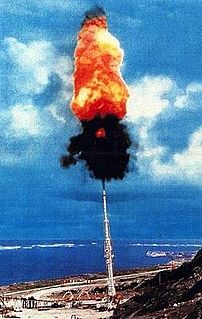John Hunter (born November 14, 1955) is an American projectile researcher, who developed the 1994 "supergun" Super High Altitude Research Project (SHARP) at the Lawrence Livermore National Laboratory. The ultimate aim of his research is to shoot payloads into space, at less than one tenth of the cost of unmanned rockets. John Hunter was the director of Quicklaunch until 2012 and currently runs a startup called Green Launch that is developing a light gas gun concept [1] [2]

Aeronautics is the science or art involved with the study, design, and manufacturing of air flight–capable machines, and the techniques of operating aircraft and rockets within the atmosphere. The British Royal Aeronautical Society identifies the aspects of "aeronautical Art, Science and Engineering" and "The profession of Aeronautics ."

Robert Zubrin is an American aerospace engineer, author, and advocate for human exploration of Mars. He and his colleague at Martin Marietta, David Baker, were the driving force behind Mars Direct, a proposal in a 1990 research paper intended to produce significant reductions in the cost and complexity of such a mission. The key idea was to use the Martian atmosphere to produce oxygen, water, and rocket propellant for the surface stay and return journey. A modified version of the plan was subsequently adopted by NASA as their "design reference mission". He questions the delay and cost-to-benefit ratio of first establishing a base or outpost on an asteroid or another Apollo program-like return to the Moon, as neither would be able to provide all of its own oxygen, water, or energy; these resources are producible on Mars, and he expects people would be there thereafter.

A rocket is a spacecraft, aircraft, vehicle or projectile that obtains thrust from a rocket engine. Rocket engine exhaust is formed entirely from propellant carried within the rocket. Rocket engines work by action and reaction and push rockets forward simply by expelling their exhaust in the opposite direction at high speed, and can therefore work in the vacuum of space.

Spacecraft propulsion is any method used to accelerate spacecraft and artificial satellites. In-space propulsion exclusively deals with propulsion systems used in the vacuum of space and should not be confused with space launch or atmospheric entry.

Robert Hutchings Goddard was an American engineer, professor, physicist, and inventor who is credited with creating and building the world's first liquid-fueled rocket. Goddard successfully launched his rocket on March 16, 1926, which ushered in an era of space flight and innovation. He and his team launched 34 rockets between 1926 and 1941, achieving altitudes as high as 2.6 km (1.6 mi) and speeds as fast as 885 km/h (550 mph).

Project HARP, short for High Altitude Research Project, was a joint venture of the United States Department of Defense and Canada's Department of National Defence created with the goal of studying ballistics of re-entry vehicles and collecting upper atmospheric data for research. Unlike conventional space launching methods that rely on rockets, HARP instead used very large guns to fire projectiles into the atmosphere at extremely high speeds.

Laser propulsion is a form of beam-powered propulsion where the energy source is a remote laser system and separate from the reaction mass. This form of propulsion differs from a conventional chemical rocket where both energy and reaction mass come from the solid or liquid propellants carried on board the vehicle.

A space gun, sometimes called a Verne gun because of its appearance in From the Earth to the Moon by Jules Verne, is a method of launching an object into space using a large gun- or cannon-like structure. Space guns could thus potentially provide a method of non-rocket spacelaunch. It has been conjectured that space guns could place satellites into Earth's orbit, and could also launch spacecraft beyond Earth's gravitational pull and into other parts of the Solar System by exceeding Earth's escape velocity of about 11.20 km/s. However, these speeds are too far into the hypersonic range for most practical propulsion systems and also would cause most objects to burn up due to aerodynamic heating or be torn apart by aerodynamic drag. Therefore, a more likely future use of space guns would be to launch objects into Low Earth orbit, at which point attached rockets could be fired or the objects could be "collected" by maneuverable orbiting satellites.

Annie Jean Easley was an American computer scientist, mathematician, and rocket scientist. She worked for the Lewis Research Center of the National Aeronautics and Space Administration (NASA) and its predecessor, the National Advisory Committee for Aeronautics (NACA). She was a leading member of the team which developed software for the Centaur rocket stage, and was one of the first African-Americans to work at NASA. Easley was posthumously inducted into the Glenn Research Hall of Fame in 2015. On February 1, 2021, a crater on the moon was named after Easley by the IAU.
The Super High Altitude Research Project was a U.S. government project conducting research into the firing of high-velocity projectiles high into the atmosphere using a two-stage light-gas gun, with the ultimate goal of propelling satellites into Earth orbit. Design work on the prototype space gun began as early as 1985 at the Lawrence Livermore National Laboratory in California and became operational in December 1992. It is the largest gas gun in the world.

Connections is a science education television series created, written, and presented by science historian James Burke. The series was produced and directed by Mick Jackson of the BBC Science and Features Department and first aired in 1978 (UK) and 1979 (US). It took an interdisciplinary approach to the history of science and invention, and demonstrated how various discoveries, scientific achievements, and historical world events were built from one another successively in an interconnected way to bring about particular aspects of modern technology. The series was noted for Burke's crisp and enthusiastic presentation, historical re-enactments, and intricate working models.

Half-Life 2: Episode Two is a 2007 first-person shooter game developed and published by Valve. Following Episode One (2006), it is the second of two shorter episodic games that continue the story of Half-Life 2 (2004). Players control Gordon Freeman, who travels through the mountains surrounding City 17 to a resistance base with his ally Alyx Vance. Like previous games in the series, Episode Two combines shooting, puzzle-solving and narrative elements, but adds expansive environments and less linear sequences.

Mad as a Mars Hare is a 1963 Warner Bros. Merrie Melodies cartoon directed by Chuck Jones and Maurice Noble. The short was released on October 19, 1963, and stars Bugs Bunny and Marvin the Martian. The cartoon's title is a play-on-words of the famous phrase to be "mad as a March hare", the origins of which are disputed. This is Marvin's final appearance in the Looney Tunes shorts during the Golden Age of American Animation.

Non-rocket spacelaunch refers to concepts for launch into space where much of the speed and altitude needed to achieve orbit is provided by a propulsion technique that is not subject to the limits of the rocket equation. A number of alternatives to rockets have been proposed. In some systems, such as a combination launch system, skyhook, rocket sled launch, rockoon, or air launch, a portion of the total delta-v may be provided, either directly or indirectly, by using rocket propulsion.

The National Aeronautics and Space Administration is an independent agency of the U.S. federal government responsible for the civil space program, aeronautics research, and space research.

The space policy of the Barack Obama administration was announced by U.S. President Barack Obama on April 15, 2010, at a major space policy speech at Kennedy Space Center. He committed to increasing NASA funding by $6 billion over five years and completing the design of a new heavy-lift launch vehicle by 2015 and to begin construction thereafter. He also predicted a U.S.-crewed orbital Mars mission by the mid-2030s, preceded by the Asteroid Redirect Mission by 2025. In response to concerns over job losses, Obama promised a $40 million effort to help Space Coast workers affected by the cancellation of the Space Shuttle program and Constellation program.
Quicklaunch is a currently inactive company attempting to use a type of space gun to launch payloads into low Earth orbit. It is a university spin-off of the SHARP project which ended 2005.

The Japanese space program originated in the mid-1950s as a research group led by Hideo Itokawa at the University of Tokyo. The size of the rockets produced gradually increased from under 30 cm (12 in) at the start of the project, to over 15 m (49 ft) by the mid-1960s. The aim of the original research project was to launch a man-made satellite.

Eleanor Crockett Pressly was an American mathematician and aeronautical engineer in the sounding rocket program at NASA's Goddard Space Flight Center.

Raptor is a family of full-flow staged-combustion-cycle rocket engines developed and manufactured by SpaceX for use on the in-development SpaceX Starship. The engine is powered by cryogenic liquid methane and liquid oxygen ("methalox") rather than the RP-1 and liquid oxygen ("kerolox") used in SpaceX's prior Merlin and Kestrel rocket engines. The Raptor engine has more than twice the thrust of SpaceX's Merlin 1D engine that powers the Falcon 9 and Falcon Heavy launch vehicles.